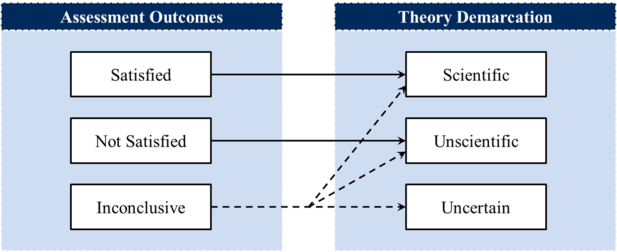The Law of Compatibility (Fraser-Sarwar-2018)
This is an answer to the question Mechanism of Compatibility that states "If a pair of elements satisfies the compatibility criteria employed at the time, it becomes compatible within the mosaic; if it does not, it is deemed incompatible; and if assessment is inconclusive, the pair can become compatible, incompatible, or its status may be unknown."
The Law of Compatibility was formulated by Patrick Fraser and Ameer Sarwar in 2018.1 It is currently accepted by Scientonomy community as the best available answer to the question.
Contents
Scientonomic History
Acceptance Record
| Community | Accepted From | Acceptance Indicators | Still Accepted | Accepted Until | Rejection Indicators |
|---|---|---|---|---|---|
| Scientonomy | 9 October 2021 | The theory became accepted as a result of the acceptance of the respective suggested modification. | Yes |
Suggestions To Accept
Here are all the modifications where the acceptance of this theory has been suggested:
| Modification | Community | Date Suggested | Summary | Verdict | Verdict Rationale | Date Assessed |
|---|---|---|---|---|---|---|
| Sciento-2018-0018 | Scientonomy | 28 December 2018 | Accept the new dynamic law of compatibility which specifies how exactly two elements become to be considered compatible or incompatible within a mosaic. | Accepted | It was agreed that the "modification provides a great addition to the current body of scientonomic knowledge"c1 as the law offers "a dynamic account of compatibility"c2 and "allows for a diachronic study of compatibility".c3 The law was praised for its non-tautological nature, since it "forbids a number of logically conceivable scenarios".c4 While finding the law acceptable, one of the commentators raised an important question for future scientonomic research: do we even need a separate law of compatibility? Specifically they asked: "Is assessment for compatibility with other elements of the mosaic really conceptually distinct from the process of assessment for theory acceptance, which is already covered by other scientonomic laws?"c5 On this view, "the issue of the conceptual separability of theory compatibility and theory acceptance, and thus the need for two parallel laws, remains an open question that warrants further investigation".c6 | 9 October 2021 |
Question Answered
The Law of Compatibility (Fraser-Sarwar-2018) is an attempt to answer the following question: Under what conditions can two elements coexist in the same mosaic?
See Mechanism of Compatibility for more details.
Description
The law of compatibility links the compatibility criteria with various assessment outcomes. If compatibility is defined as the ability of a pair of elements to co-exist in the same mosaic, then the assessment for compatibility is essentially the process by which the epistemic agent decides whether any given pair of elements (i.e. theories, questions, methods) can be simultaneously part of their mosaic. Such an assessment can yield three possible outcomes - satisfied, not satisfied, and inconclusive.1p. 73 Accordingly, the law of compatibility states that if a pair of elements does satisfy the compatibility criteria of the time, then it is deemed as compatible. If, however, an element is taken to be incompatible with the other one, then the pair is deemed as incompatible. Finally, the assessment of compatibility may be inconclusive. In this case, the pair may be deemed compatible, incompatible, or its status may remain unknown. The diagram below summarizes the relation between assessment outcomes and their effects:
Reasons
No reasons are indicated for this theory.
If a reason supporting this theory is missing, please add it here.
Questions About This Theory
The following higher-order questions concerning this theory have been suggested:
If a question about this theory is missing, please add it here.
References
- ^ Fraser, Patrick and Sarwar, Ameer. (2018) A Compatibility Law and the Classification of Theory Change. Scientonomy 2, 67-82. Retrieved from https://scientojournal.com/index.php/scientonomy/article/view/31278.

